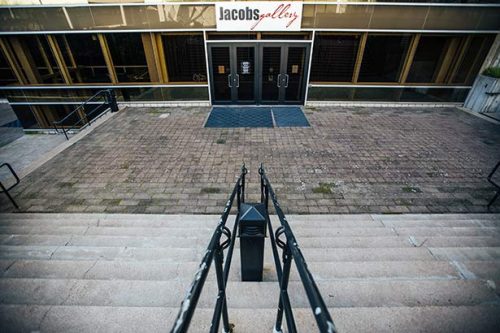
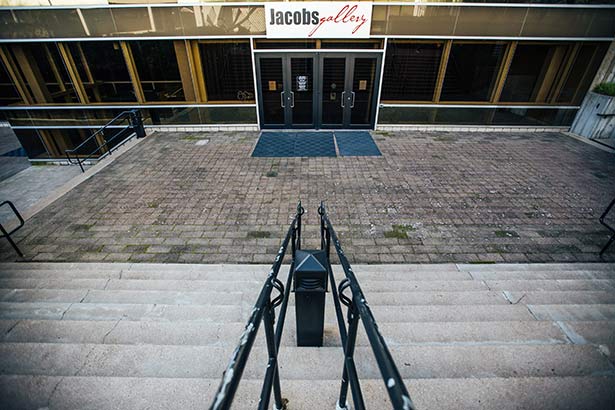
Eugene: The World’s Greatest City for the Arts and Outdoors.
That was Eugene’s, ahem, slightly overstated city slogan until 2010.
The city then rolled it back to:
Eugene: A Great City for the Arts and Outdoors.
Never has the chasm between “the” and “a” been so wide.
As of Jan. 31, the Jacobs Gallery, located in the basement of the Hult Center — the only city-subsidized visual arts venue — closed after 18 years. Perhaps the powers that be should tone the slogan down once more:
Eugene: A City Where People Go Outdoors.
Some of you may huff and puff while reading this about your town. What about the theater? The symphony? The ballet? Yes, relatively speaking, the performing arts are doing well, supported by grants, dedicated audiences and residencies at the Hult Center for Performing Arts and other venues.
This story is not about the performing arts; it’s about the visual arts — murals and sculpture, painting, photography and printmaking, ceramics and video, graphic design and illustration.
Or as veteran local arts reporter Bob Keefer explains: “The visual arts help us see the world and create the future.”
But even in a town stocked with artists, the visual arts are in big trouble.
Depending on who you talk to, reasons for this state of emergency are myriad — Eugene has an art-making but not art-buying public; the city of Eugene does not financially support the visual arts like it does other cultural endeavors; the lack of arts education in schools; art made in Eugene is not up to snuff.
There does seem to be one universal truth everyone agrees on: There’s no money for the visual arts.
The Jan. 31 closing of Jacobs Gallery has become a flashpoint for defunding or underfunding the arts. The gallery was a public-private partnership — the closest thing Eugene had to a public visual arts space — that was home to the annual Mayor’s Art Show. The city stopped its annual funding of the gallery in 2014.
The Jacobs Gallery has joined a growing pit of cultural erosion in Eugene. The Gallery at the Watershed closed its doors in August, in the wake of several Eugene galleries closing in the last decade. In 2015, the Downtown Initiative for the Arts (DIVA) shuttered in Eugene due to lack of resources, reopening shop in Drain, Oregon. The Eugene Celebration, which was kicked off each year by the Mayor’s Art Show, has dissolved with no real explanation.
At the heart of this issue is the fact that for decades the visual arts community has been practically begging for support from the city, including calls for the city to run a municipal art center and/or museum, which could house the city’s public art collection of more than 200 works that are currently scattered haphazardly around the city.
Eugene has no central public hub for the visual arts like, say, Roseburg’s Umpqua Valley Arts Center or what the Hult Center is to Eugene’s performing arts community.
Will the city, its government as well as its citizens, save the visual arts from floundering? I looked for clues in the closing of the Jacobs Gallery and the city’s commitment to the visual arts, past and present, as well as its sources for funding the arts, including the outdated One Percent for Art Ordinance (Here’s a hint: Eugene has fallen behind on national best practices.)
Rest assured, there are some slivers of hope. The Eugene visual arts community will not go gentle into that good night.
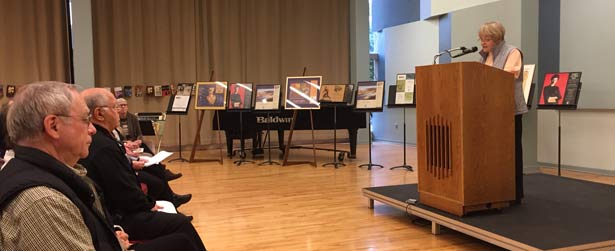 |
| Alex Brokaw thanks Jacobs Gallery volunteers and supporters at a tribute event Jan. 9 |
The Jacobs Story
In November 2015, the Jacobs Gallery nonprofit board decided it would shut down after nearly two decades. To be clear here, there are two Jacobs Galleries — the nonprofit that ran the space and the actual space itself in the basement of the Hult Center. The nonprofit folded; the actual physical space is in limbo.
The nonprofit’s last board president, Alex Brokaw, says it’s important to focus on the positive. “What I want to do is stress that the gallery has been open for 18 years that it would not have been open.”
It’s true; this is not the first time the space has closed. In the late ’90s, due to budget cuts, the city of Eugene decided to close the then-community room art gallery. Within weeks, Brokaw says, a volunteer group of citizens, led by the “absolute dynamo” Laurel Fischer (who recently passed away), swooped in to re-open it as the Visual Arts Consortium.
The group went on to gain nonprofit status and renamed itself after Maurie Jacobs, the late Eugene businessman and arts advocate who was key in lobbying for the $18.5 million measure that got the Hult Center built during the economically depressed 1970s.
“They supported the gallery with passion but they also supported the gallery with money,” Brokaw says of this early Jacobs Gallery group. “So many of those people are gone now.”
Brokaw says the Jacobs Gallery nonprofit held a fundraiser in October with the goal of netting a minimum of $30,000. They were “not even close” to reaching that, she says.
“We looked at the bottom line and we decided that we just really couldn’t go on,” Brokaw says.
Previously, the Jacobs Gallery had managed to survive if not flourish due to a combination of membership fees, fundraisers, art sales, donations and sponsorships as well as annual funding and subsidized rent from the city. It was a hub for long-established local artists like Jerry Ross, Analee Fuentes, John Rose and Tallmadge Doyle.
“It was an anchor, even if it was just psychological,” artist Jerry Ross says. “It said: ‘OK, right here in the heart of downtown is still a public art gallery, a public-private partnership in the interest of the citizens of the city.’”
A Community on Fire
After the announcement that Jacobs Gallery would officially close Jan. 31, 2016, the city of Eugene hosted “A Community Conversation about the Jacobs Gallery Space.”
In my three-plus years as an arts editor, I have never witnessed such fiery passion expressed in the name of visual arts in Eugene.
On the evening of Jan. 13, more than 100 people filled The Studio, a room next to the Jacobs Gallery in the basement of the Hult Center, to find out, in their words, what the hell happened to one of Eugene’s last-standing galleries. The city intended the event to be a discussion of what was next for the soon-to-be vacant Jacobs Gallery space. That is not, however, what transpired.
“We’re here today because the nonprofit that operates Jacobs Gallery has decided to close,” said Tomi Anderson to the crowd, explaining that she wanted to address some rumors. Anderson has been the city of Eugene’s Cultural Services director since 2013.
“It’s not because the city is closing them down; it’s not because we cancelled their lease,” Anderson continued. “It’s that the Jacobs Gallery board made a decision that it was time for them to fold.”
“It’s deeply saddening to me to know that the Jacobs Gallery is closing,” she added. To this, there was a palpable collective shift in the audience, followed by groans, whispers and shouts.
Local artist Jerry Ross yelled out, asking what the city expected to happen after it cut Jacobs’ funding.
“It’s always been known that that funding would go away,” Anderson replied. “They have not asked to be saved; they have not requested money from the city.”
Amy Isler Gibson, owner-operator of the recently closed Gallery at The Watershed, asked the city to slow the conversation down, explaining that it would be hard for people to move forward if they were struggling to understand how this city could possibly allow Jacobs Gallery to close in the first place.
“Sixteen years ago, I did some research and discovered Eugene was one of the largest cities in the entire United States without a funded or endowed museum or art museum,” said Otto Poticha, local architect, arts advocate and former board member of the Jacobs Gallery nonprofit. “That’s embarrassing.”
A Jacobs Gallery board member also stood up and took the mic, telling the audience that this was not the appropriate event to criticize the city or the board, a comment that confused many.
Then, despite several pleas to hash out the issue as a large group, the city’s facilitators asked people to break into nine different focus groups. And so it was.
Many, including myself, walked away with questions.
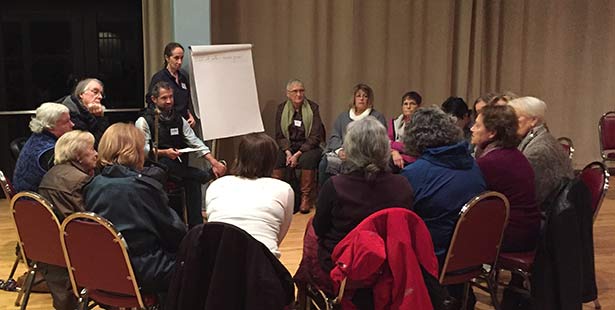 |
| Public art manager Isaac Marquez leads a group at the City’s ‘Community Conversation’ about Jacobs Gallery Jan. 13 |
The Bigger Picture
Bob Keefer, himself a photographer that showed at the Jacobs Gallery, quickly reported the Jan. 13 city-run Jacobs Gallery “Community Conversation” on his blog EugeneArtTalk.com
Keefer sums up the night: “It was all too bad. No one from either the Jacobs or the city shed much light on the gallery’s closing — a fiasco that reflects badly, no matter how you spin it, on Eugene’s commitment to the arts.”
Wanting to ferret out how Eugene arrived at this state of the visual arts, especially when the performing arts seem to be thriving in comparison, I went to some veterans, including Keefer, of the local art scene.
“Performing arts have organizations, they have a political structure,” he says. “Visual arts are more isolated.”
Keefer adds that performing arts orgs, like the Oregon Bach Festival, have major fundraising apparatuses. And the performing arts, in general, can be more approachable than the visual arts: Buy a ticket, plop in a seat and enjoy the show. With visual art, not everyone feels at ease mulling over the meaning of a painting in a gallery.
Keefer points out that Oregon, and the West in general, does not have the strong tradition of visual arts patronage that the East Coast and Europe have.
“The old money here is tempered,” he says.
Courtney Stubbert, a visual designer who runs Arts Digital and Eugene Contemporary Art, says Eugene’s moneyed class tends to lean conservative. Stubbert also sits on the city’s Public Art Committee
“Money tends to go to the ballet and the symphony,” he says. “Performing arts at the Hult Center is a known quantity on the spreadsheet. They know the number of seats.”
Several people, including Keefer and Stubbert, also pointed to the lack of cultivating art lovers in Eugene.
“It’s a failure of education,” Keefer says.
“School is definitely not the place where it is happening,” Stubbert says. Stubbert says he teaches his children about the visual arts, and the abstract, spatial and critical-thinking skills it entails, at home.
Miriam Jordan, former Jacobs Gallery board member and former president of the Downtown Visual Arts Initiative, says lack of arts education in Oregon schools is the number one issue. She has an M.S. in arts management from the UO
“The visual arts are considered a luxury,” Jordan says of the attitude in Eugene. But “children are suffering from a lack of an arts education.”
The Lane Arts Council has made great strides with its ArtCore program, bringing the arts back into middle school curriculum, but its reach is currently capped at only a handful of Lane County schools.
In spite of all this, Jordan says she was taken by surprise when the gallery closed. “It was the gallery I thought would always be around,” she says.
Everything Has Shrunk
The failure to meet the fundraising goal is not the only reason the Jacobs Gallery nonprofit is no more. Jacobs rode out a recession, but the financial collapse has taken its toll on all arts funding.
“The thing is, sponsorships 10 or more years ago would be maybe $5,000, and now they might be $1,000 or $500,” Brokaw says. “The times have changed. Everything has shrunk.”
Technology has also influenced how people buy art. It is no longer necessary to go to a brick-and-mortar gallery to purchase original art; online galleries are proliferating and sites like Etsy allow artists to sell directly to customers.
Then there’s the funding from the city, or lack thereof. Until 2014, the city of Eugene, through the division of Cultural Services, helped fund the gallery through a tiered financing plan, or what Tomi Anderson calls stabilization funding, essentially helping the gallery build a financial foundation.
Beginning in the early 2000s, the city gave the nonprofit $30,000 a year, an amount that was scheduled to go down to $25,000, then $20,000, eventually bottoming out at $15,000 in 2014 — the last year the city gave annual support.
Many in the arts community say the city should have financially supported it more, but anything was better than nothing.
“When you’ve got a base, something to jump off of, you’re able to earn double that,” Brokaw says. “It gave the board, it gave the staff, just that feeling of support from the city, which is important, to feel like you are being supported, that your work is recognized.”
Brokaw says she and some members of the board went to Mayor Kitty Piercy in January 2015 with concerns about the ability to keep the gallery afloat. The mayor was very sympathetic, Brokaw says.
However, no saving grace came to the aid of the Jacobs Gallery, and on Nov. 3, 2015, Library, Recreation and Cultural Services Executive Director Renee Grube announced in an email to the mayor and City Council that the gallery would close Jan. 31, 2016.
“This change was not anticipated by our staff, but came after some very difficult decisions made by the Jacobs Gallery board,” Grube wrote. “We are saddened by this turn of events and this will come as a surprise to the community as the gallery is loved by many.”
When asked what kind of guidance and support was given to the Jacobs Gallery before they decided to close, Piercy responded in an email to EW:
“I asked Renee Grube to follow up and see what the city could do to be helpful,” Piercy writes. “I gave them my support and talked with people quite a bit. As far as I know the board did not let the city know until after they had made the decision to close. It came as a sad surprise to me when they met with me to let me know, although I was fully aware of their funding challenges.”
On Dec. 17, Jerry Ross emailed City Councilor Betty Taylor asking that the city save the gallery. “I’m advocating that the gallery be both owned and staffed by the city,” Ross wrote.
Taylor responded the same day. “I agree with you and have expressed my opinion to the city manager and the mayor, as well as at public meetings.”
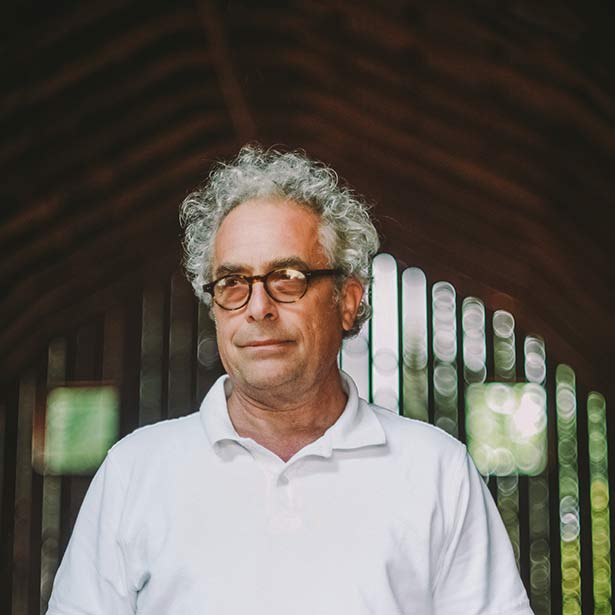 |
|
‘The city has been looking for places to cut the budget, and it gives a lie to the declaration
that the city of Eugene is the city of the arts and outdoors because they have never put their money where their mouth is.’ – Jerry Ross |
Commitment Issues
It’s difficult to pinpoint the extent of the city’s commitment to the visual arts, both financially and symbolically. One reason it’s murky is because the visual arts are folded into the larger operating budget of the Cultural Services division, which doesn’t differentiate between the visual arts and the performing arts (i.e., theater, dance, music, comedy).
“The bifurcation of visual arts and performing arts feels unnatural,” Cultural Services Director Anderson tells me. “To me, they really seem woven together.”
As art becomes more multi-disciplinary, it’s true that the distinction between visual arts (think 2D art) and performing arts tends to blur more frequently.
However, lumping the visual arts in with performing arts, which are the dominant focus of the Hult Center, is also an easy way for the visual arts to be lost in the fray.
Anderson explains that the city does support the visual arts in many ways, the efforts just aren’t as visible as the performing arts.
“We do not support an art center currently,” Anderson says. “But we do support tons of arts programming, but a lot of it is distributed through the community in ways people don’t see.”
Anderson adds that the city also supports the visual arts by maintaining different venues, funneling grants through Lane Arts Council, hosting community events and the city’s public art program, “which is kind of quiet in the background.”
Isaac Marquez has been the city’s public art manager since 2010. The position, however, is halftime (.5 FTE), which he combines with another half-time position helping organize and host Cultural Services events like the annual (sub)Urban Projections mutlimedia festival.
“The art that the city owns, we’ve pieced together a little funding and we do a better job of caring for it and maintaining it now,” Marquez says, pointing out that before his half-time position was created in 2010, there was no public art manager.
Eugene has more than 200 commissioned and donated works in its collection. Some of these art works are outdoors — Pete Helzer’s Ken Kesey statue or the new skate park murals, for example — and some are displayed in public buildings around town, while others are in storage and others still are unaccounted for.
“The database is not up to date,” Marquez says. “It’s kind of embarrassing that we don’t have this really high-end inventory system, but we’re not like a museum.” He says in June he is getting help to revamp the system.
Numbers Speak Louder Than Words
In January 2010, the city released the Eugene Public Art Plan. The plan came to fruition through a $25,000 National Endowment of the Arts grant and the participation of the Eugene Public Art Committee and a 14-person steering committee, as well as stakeholder interviews with more than 400 Eugeneans, from City Manager Jon Ruiz to EW’s own music writer William Kennedy.
The plan, prepared by Portland consulting firm Barney & Worth, Inc., in association with Oregon’s Regional Arts & Cultural Council, draws many conclusions about Eugene’s relationship to the visual arts.
The good news: “Eugene has emerged as an arts destination, with an abundance of arts and cultural offerings enjoyed by visitors and residents alike.”
It should be noted that the Jacobs Gallery, which is mentioned in the plan, and other art galleries have closed since the information was gathered.
There are several areas where the plan identifies that Eugene has fallen behind best practices:
For midsize cities (populations of 100,000 to 250,000), the average annual budget for public art programs is $330,000. “The city of Eugene’s most recent completed budget year shows the Public Art Fund with total resources of $213,000,” the plan states. The city has not yet responded to a request for the program’s current budget.
It also states, “Unlike its peers, Eugene has not developed a robust array of printed brochures, maps, web information and other interpretive materials” of its public art. In other words, the city of Eugene has not made its public collection accessible to the public.
And despite Eugene being one of the earliest adopters of the percent-for-art funding model in 1981 — a model now used by more than 75 percent of public art programs nationwide — the city has since faltered.
Eugene’s One Percent For Art ordinance currently requires that one percent of funds for all city construction and remodeling projects go to the public art fund, which funds art commissions, infrastructure and maintenance.
Peer cities have moved from a one percent to two percent model, have widened the scope of eligible funding to include transportation projects and have calculated the percentage for art on the city’s entire capital budget, including purchases of land, buildings and machinery.
“The rationale for Eugene’s unusually narrow percent-for-art definition is no longer clear,” the plan states. “Eugene’s funding level of one percent for capital projects also now falls behind national best practices.”
The plan also makes recommendations for city staffing. “The program still does not have a full-time, dedicated staff, an ingredient that is essential for ongoing success.” Under national best practices, the plan states that peer cities typically have “two (or more) full-time staff.”
A Public Hub for the Visual Arts
On Nov. 4, 2015, Mayor Piercy wrote an email to Grube, Anderson and the City Council.
“It is my great hope and determination that we will use this moment of change with the Jacobs to do something really important and innovative in the visual arts for/with our city.”
She continues: “Two things come to my mind. One is that we have a collection of some fine local art pieces and no place to show them in a focused and meaningful way. I have long been interested in us showing the local art and artists that we have in our city collection. Artists have told me they would contribute additional pieces if they knew they would be part of a city collection and would be shown.”
Piercy goes on to say that the Jacobs Gallery folks are interested in a venue that “teaches and nourishes artists,” while the UO’s Jordan Schnitzer Museum of Art “has long talked about a downtown presence. Is there some connection here?”
She concludes by saying: “Let’s not be pedestrian and let us take advantage of this opportunity.”
Perhaps this is the moment for which the visual arts community has been advocating for decades, the moment to build a public art center and museum. Maybe Eugene can have an art center, which many in the arts community say could be run in a similar fashion to the city-run rec centers in town, with art classes, studio space and a permanent gallery space where the city’s public art collection could be on view and easily accessible to its citizens.
And while the visual arts community stated that the art hubs Eugene does have — like Maude Kerns Art Center, the volunteer-run New Zone Gallery and the Schnitzer — are essential to local visual arts, fundamentally they have different missions than a public art center.
“There’s collections everywhere and they need to be in one place,” Miriam Jordan says of the city’s art. “Our heritage is scattered everywhere.”
Lane Arts Council Executive Directer Liora Sponko says she and the LAC board would support a public art center. “An art center would put us on the map as an exceptional art city. It could bring cultural tourists for us.”
Several are wary that the city does not have the commitment to the visual arts, both financially and culturally, to build a central public art hub.
“You notice there is never anything coming from the city manager, very little from the mayor and definitely complete silence from the City Council regarding the cultural heritage of the city of Eugene,” artist Ross says.
Ross, for one, has long advocated that the city purchase the U.S. Post Office building at 520 Willamette St., which was for sale in years past, and turn it into a public art museum and art center. The post office is home to federally protected WPA murals, an effort that Ross spearheaded, and thus anyone who buys the building cannot alter these murals.
The post office is no longer on the market, but you can read about Ross’ efforts at poempnw.wordpress.com.
Others have suggested the old, vacant Lane Community College building downtown and EWEB’s old, vacant steam plant as potential homes for an art center. Old buildings are good for the arts as they typically cost less to rent.
“It’s a matter of who’s going to fund it? Who’s going to create it?” Sponko asks.
The One-Percent
“You can imagine that half the people in this community, or any community, don’t think the government should be funding the arts at all,” Anderson says. She adds that she’s unsure what role the city should play in the visual arts community.
“Making sure there is equitable access and that we’re reaching all areas of the community, that’s really what we’re best at and probably what’s our most appropriate role,” Anderson says.
But could the city initiate community partnerships to finally build some sort of central public hub for the visual arts?
“Yes, and we’re exploring a couple things that I can’t really talk about,” Anderson says.
In the end, it always comes down to money. But perhaps the city could finally reevaluate the One Percent for Art ordinance and follow the recommendations from the Eugene Public Art Plan to move to a two percent model.
“I think that Eugene’s Percent for Art program is awesome and I think it could grow and expand,” Anderson says. “That would immediately double our percent for art budget for projects. The more funding that we have through those — obviously we can create more art — but we can also create the infrastructure to maintain and take care of it.”
As Marquez and Anderson point out, changing the percent for art ordinance is a policy decision that is up to the Eugene City Council.
It’s also something citizens of Eugene at large need to answer for themselves. Should the city increase its financial support of the visual arts?
“I think that would be a great question to ask the community,” Marquez says.